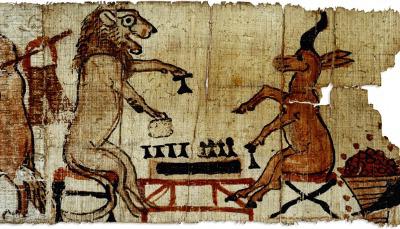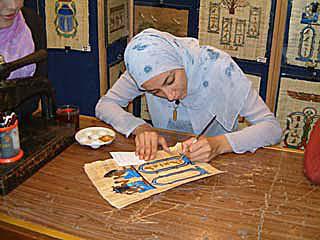The ancient technology of manufacturing material that replaced Egyptian priests and officials with paper, for many centuries remained in oblivion. This is not only due to the state monopoly on the production of papyrus and zealous preservation of craft secrets, but also climate change in the Nile Delta and environmental problems. As a result of the latter, papyrus in Egypt is almost extinct. Only in the second half of the 20th century, the enthusiast Hassan Ragab became concerned about the revival of this plant and the study of the possibilities of its use. It is thanks to his research that the modern person knows the process of making papyrus.
The value of papyrus for the ancient Egyptians
A tropical hygrophilous plant belonging to sedges and related to satiety, several thousand years ago formed impressive thickets on the marshy banks of the Nile in its lower reaches. Papyrus is a high smooth shoot crowned with an "umbrella" of narrow lanceolate leaves. The inflorescence of the papyrus resembles a fan, consisting of many spikelets. The triangular stalk of papyrus is tough, flexible and durable.
It was used as a material for furniture, boats, rafts. Ropes, baskets, shoes were made from the shell. Dried plant roots were used as fuel. The soft part of the shoot, which was under water, was eaten. The same part was ideally suited for the manufacture of "paper".
Stages of papyrus manufacturing: splitting, “assembly”, press drying, polishing, gluing
The lower part of the stem was peeled, freeing dense, fibrous and sticky pulp. It was split into thin plates 40-50 cm long. Modern technology involves soaking strips for several days.
Finished plates (fillets) were overlapped on a flat surface covered with fabric and leather: the first layer is parallel to the edge of the table, the second is perpendicular. At first, the width of the finished sheet was no more than 15 cm, but later the Egyptians learned to make quite wide canvases. In the process of laying the material was wetted with water from the Nile.
Then the sheets were placed under a press. This was necessary so that the strips stuck together, and the papyrus became thin and homogeneous.
Nuances and little-known facts
What is the technology for making papyrus is easy to explain. All the complexity lay in the nuances. So, the longer the papyrus was kept under pressure or pre-soaked, the darker it turned out. It was important not to delay the process: the Egyptians preferred light material. The surface of the sheets was treated with a special composition that prevented ink from spreading. It was made from vinegar, flour and boiling water. Having removed the sheets from the press, the craftsmen beat them with special hammers and smoothed them with polishing stones, pieces of wood or bone. Prepared papyri was dried in the sun. Then they were glued together to make a scroll. The Egyptians paid attention to the direction of the fibers, so it was almost impossible to find a "seam". They wrote, as a rule, on one side (which the Romans subsequently called recto). The manufacture of papyrus in ancient Egypt was put on stream. They sold it in rolls: “cuts” and “by weight”.
Papyrus in antiquity
“Pap per aa,” or “material of the kings,” was the name of the Egyptians themselves. They began to use papyrus in the 3rd millennium BC. e. The Greeks borrowed the term, slightly changing its pronunciation. It should be noted that Egypt provided the entire ancient world with papyrus , and this continued until approximately 800 A.D. e. Decrees, literary and religious texts were recorded on it, colorful illustrations were made. In the 1st century AD e. historian Pliny the Elder in his work "Natural History" touched on the question of what is the technology of manufacturing papyrus. However, the information provided by him was rather scarce in order to restore the craft.

According to Strabo and Pliny, there were several varieties of papyrus. August, Libya and the hieratic were considered the best during the Roman Empire. This was followed by the amphitheater (Alexandria), Saitic and Teneothean. All of them were intended for writing. The Egyptians also traded "merchant paper" - a cheap "wrapping" papyrus.
Revival of craft secrets
“What is the technology for making papyrus?” - This question began to worry Hassan Ragab, the Egyptian ambassador in the Middle Kingdom, when he met a Chinese family engaged in the production of paper in the traditional way. That was in 1956. Returning to his homeland, Ragab bought the land for plantation, brought the local papyrus from Sudan and engaged in scientific research. Ragab and his students managed to make a papyrus, not inferior in quality to the oldest samples. On it, talented Egyptian artists performed murals: copies of the illustrations found in tombs and original works.

It is still difficult to say whether the modern Ragaba papyrus will be as durable as the ancient Egyptian one. In addition, the climate has changed, it has become more humid, and the moisture of the papyrus deteriorates. It is also unknown how accurately Ragab reproduced the process of making papyrus. Perhaps he brought something of his own to him. But, one way or another, modern scrolls and decorative panels are successfully sold, and information on what is the technology of making papyrus is available to every curious tourist.